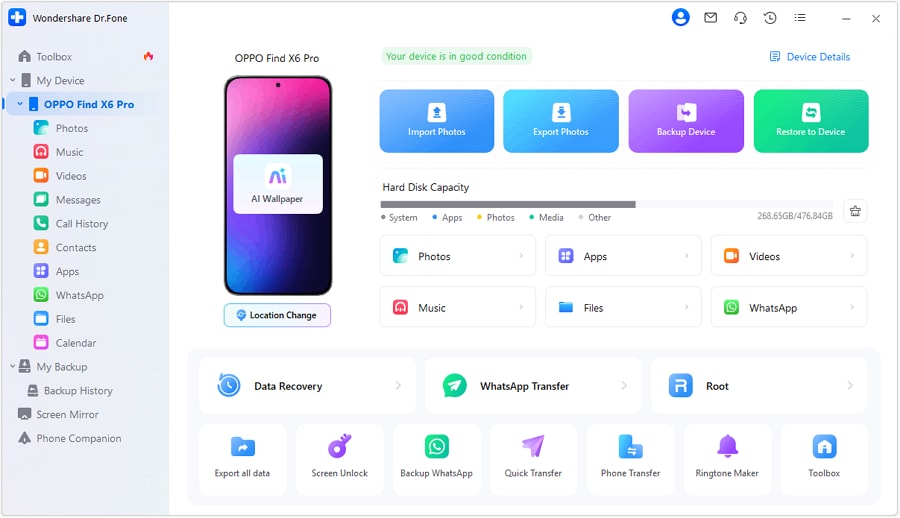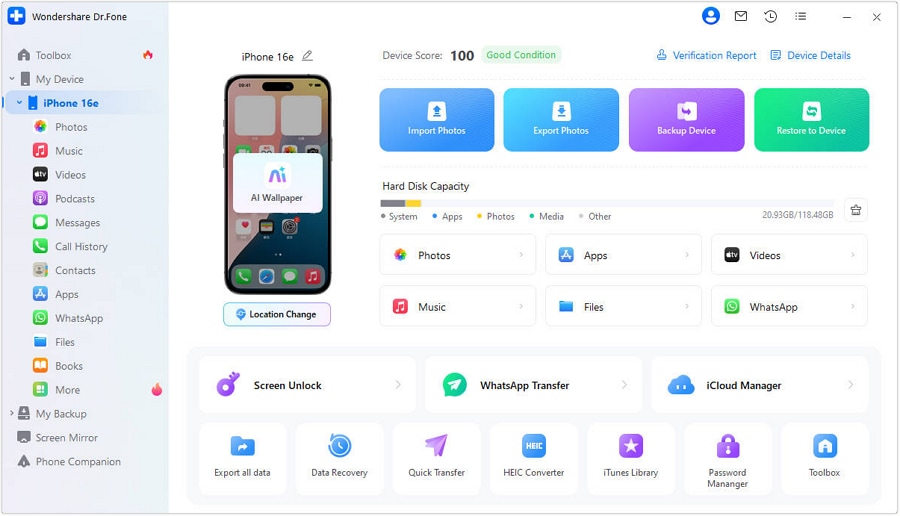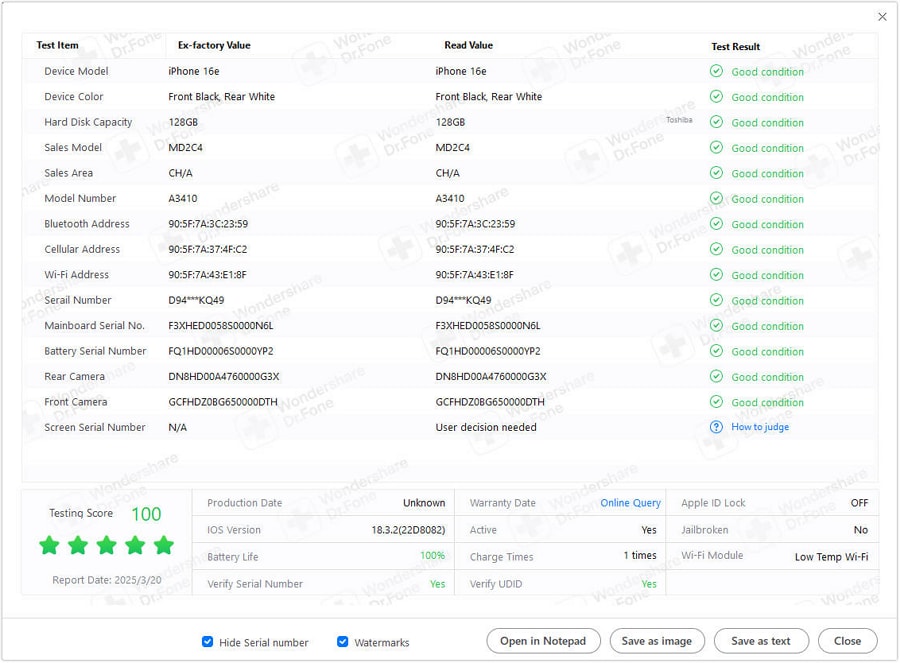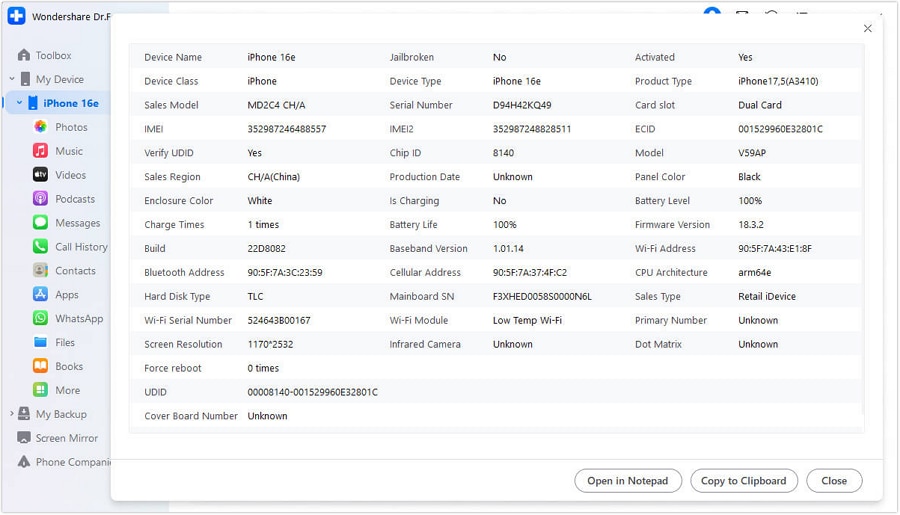[Detailed Guide] How To Check If Your Android Phone Is Rooted
Oct 24, 2025 • Filed to: Device Data Management • Proven solutions
Dr.Fone Basic:
Better Control for Your Phone
Manage, transfer, back up, restore, and mirror your device
The term “root” refers to getting administrative or root access on an Android smartphone. This procedure gives users total access to their device's operating system, allowing them to change system settings and install new applications.
However, a rooted Android device carries a few risks, such as voiding the device's warranty or causing software problems. Thus, it's vital to determine whether your Android device is rooted for first-time users or those who have recently bought a used one.
This article will walk you through determining if your Android phone is rooted. We will also examine some pros and cons of doing so. Without further ado, let's dive right into it.

Part 1: Advantages and Disadvantages of Rooting Android
Before we find out how to check if an Android phone is rooted, it's important to understand the advantages and disadvantages of doing it:
Advantages of Rooting Android
Here are some pros of rooting an Android device:
- Install third-party apps– Rooting an Android smartphone enables users to install programs from third-party sources that are not accessible on the Google Play Store. Users can only install apps from the Google Play Store if they have rooted their devices.
- Customization options– The process of rooting an Android smartphone gives users access to a wide range of customization choices, allowing them to alter both the aesthetic and the operation of their device.
- Remove unwanted system apps– Users can free up storage space and improve their device's speed by gaining root access, enabling them to delete pre-installed system programs on their devices.
- Boost performance– Users who have their devices rooted can improve their performance by overclocking the CPU, optimizing the RAM, and extending the battery's life.
Disadvantages of Rooting Android
Here are some of the cons of rooting an Android phone:
- Vulnerable to spyware– When you root an Android smartphone, you expose it to a heightened risk of malware and other forms of cyberattack.
- Possibility of bricking your phone– The act of rooting your phone might render it inoperable if it is not carried out properly, referred to as "bricking."
- Warranty void– If you root an Android smartphone, the warranty on that device can be voided, which means that if anything goes wrong, you won't be able to fix or replace it.
- No security updates/patches– If you root your smartphone, you might not be able to get important security updates and patches, which can leave your device open to potential security risks.
Part 2: 5 Methods To Check If Your Android Phone Is Rooted
If you have rooted your Android phone or are unsure whether it is rooted, you should check the Android phone's rooting status. Depending on your device and preferences, there are numerous methods to do this.
Here are five methods for determining if your Android phone is rooted:
Method 1. Android Settings
The first method is checking via the Android's settings. It is the simplest and easiest way. Here are the steps to help you in this matter:
- Step 1: Tap the Settings option on your Android device and then navigate to the About Phone section.

- Step 2: Tap the Status Information option. Check that the Phone Status section shows Official status. If it's showing Custom or anything else, there is a chance that the device is rooted.

Method 2. Wondershare Dr.Fone (Free Android Root Checker)
Wondershare Dr.Fone is a comprehensive toolkit designed for iOS & Android users. It offers various features for data recovery, screen unlocking, phone transfer, and more. One of its standout features is the One Click Root Checker, which allows you to check if your Android phone is rooted easily.
Dr.Fone is known for its user-friendly interface and reliability, making it a go-to choice for many Android users. With Dr.Fone, you can quickly determine your phone's root status without any technical hassle.
Steps to discover if your Android phone is rooted with Wondershare Dr.Fone:
- Step 1: First, download and install the Dr.Fone software on your computer.
- Step 2: Open the Dr.Fone software on your computer. Ensure your Android phone is connected to your computer via USB. Dr.Fone will automatically detect your device.

- Step 3: You will see a dashboard with various options. Click on "Device Details" to access the One Click Root Checker feature.
- Step 4: Dr.Fone will start analyzing your phone to determine if it is rooted. If your phone is rooted, it will show "Yes" If it is not, it will display "No".

Note: For those looking to root their Android phone for full system privileges and extensive customization, our comprehensive guide to Android rooting is the perfect resource.
Ditch the hassle of multiple apps and simplify your mobile experience with Dr.Fone App, the ultimate all-in-one solution for iOS and Android users. Unlock your device, change your GPS location, and transfer WhatsApp data with ease. Plus, recover lost data from Android devices and transfer files, photos, and music between devices with ease. Fix common system issues and get the most out of Dr.Fone App with our "Tips" section below.
Dr.Fone App (iOS) & Dr.Fone App (Android)
Your One-Stop Expert for Screen Unlock, Smart Clean, Data Recovery, Change Location, and Phone Management of Mobile Devices!
- Effortlessly unlock various locks on your device.
- Instantly free up storage space by smart clean.
- Rapidly recover different kinds of lost phone data and information.
- Easily changes GPS location on Android devices.
- Easily manage cluttered and private device content.
Method 3. If There Is a Kinguser or SuperSU Icon on Your Phone
The two most popular applications for managing root permissions on your phone are Kinguser and SuperSU. If you have one of these applications installed and see its symbol in your app drawer or home screen, your phone is rooted.
You can also use the app to check an Android phone's rooting status. If you don't have a symbol of these applications, your phone isn't rooted or using a different app to handle root rights.

Method 4. Use Terminal Emulator
This method is more complicated and requires some technical knowledge and instructions. A terminal emulator is an app that allows you to access your phone's command line interface. You can use it to perform commands and see system information.
Follow these steps to check if your Android phone is rooted using a terminal emulator:
- Step 1: Install a terminal emulator app from the Google Play Store, such as Terminal Emulator for Android.
- Step 2: Open the app, type “su”, and press enter. This command requests root access from the system.
- Step 3: If your phone is rooted, you should see a prompt asking you to grant root access to the app. You can also see a symbol change from "$" to “#”, indicating that you have root privileges.
- Step 4: If your phone is not rooted, you should see an error message saying “su: not found” or “permission denied”. You can also see no change in the symbol.
Method 5. Check Through ADB Tools on the PC
It is yet another sophisticated method that necessitates computer and software applications. Android Debug Bridge is a program that allows you to communicate with your phone from your computer via a USB cable. It can be used to execute various duties and examine system information.
Follow these steps to determine if your phone is rooted using ADB tools on a PC:
- Step 1: Install ADB tools on your computer.
- Step 2: Enable USB debugging on your phone by going to Settings > Developer options > USB debugging.
- Step 3: Connect your phone to your computer via a USB cable. Open a command prompt or terminal window on your computer and navigate to the folder where you installed ADB tools.
- Step 4: Type "adb" devices and press enter. This command lists the connected devices. You should see your phone's serial number in the output.
- Step 5: Type "adb shell" and press enter. This command opens a shell session on your phone. Type "su" and press enter. This command requests root access from the system.
Note: If your phone is rooted, you should see a prompt asking you to grant root access to the computer. You can also see a symbol change from “$” to “#”, indicating that you have root privileges. If your phone is not rooted, you should see an error message saying su: not found or permission denied.

Part 3: Bonus Tip: Best Method To Check If Your iPhone is Jailbroken.
If you own an iPhone, you've heard about jailbreaking. Jailbreaking removes Apple's limitations from your device's operating system, enabling you to install customizable programs and changes. However, jailbreaking your iPhone can expose you to security vulnerabilities and instability. As a result, before modifying your iPhone, you must first determine whether it has been jailbroken.
Wondershare Dr.Fone is one of the finest tools to see whether your iPhone has been jailbroken. It's a dependable, user-friendly program that can quickly check your iPhone's jailbreak status. You can use Dr.Fone to get a device verification report containing extensive information about your iPhone's jailbreak state and specifications.

iDevice Verification Report
Dr.Fone allows you to access the device verification feature only on iOS devices. It generates a comprehensive device diagnostic report by running several tests, providing you with a detailed report, including information on whether your iPhone is jailbroken.

Device Details
With Device Details, you can access more general device information such as device model, IMEI, Wi-Fi, etc.

Note: Dr.Fone can check the device details of Android and iOS phones. However, the Phone Verification tool is not accessible for Android phones.
Key Features of Dr.Fone:
Some of the key features of Wondershare Dr.Fone are:
- Transfer files between phones or between phones and computers.
- Backup and restore phone data, either individually or in bulk.
- Unwanted files can be deleted permanently or in batches.
- Contacts, messages, photographs, videos, music, and other data can be exported and imported.
- Manage applications, music playlists, ringtones, backgrounds, and other media.
Conclusion
Before making any adjustments to your device, it is essential to determine whether your Android phone is rooted. This article discusses numerous methods for determining whether your Android device is rooted, including the use of third-party apps and built-in tools.
However, for a trustworthy and user-friendly experience, we recommend Dr.Fone, which can provide a detailed verification report and device information. With Dr.Fone, you can maintain your rooted or unrooted Android phone operating efficiently and securely.
Here're some of the frequently asked questions and their answers to eliminate any further confusion on this topic.
FAQs
Dr.Fone Basic:
Better Control for Your Phone
Manage, transfer, back up, restore, and mirror your device
Android Root
- Generic Android Root
- 1. Text Message Apps for Android
- 2. Root Android ONE Devices
- 3. Best Android Root File Managers
- 4. Get Root Access with Computer
- 5. Delete Preinstalled Apps on Android
- 6. Get Free In-APP Purchase
- 7. Wifi Hotspot Apps without Rooting
- 8. Get Root Access on Android
- 9.Root Android Devices
- 10.Root Android Phones and Tablets
- 11.Root Smartphone on Android
- 12.Why Root Android and How to Root it
- 13.Root Android 4 Series in Two Ways
- 14.Tools to Root Android Online
- 15.Root Android without PC
- Specific Android Root
- 1. Root Samsung Galaxy S7& S7 Edge
- 2. Root LG Devices with Root Script
- 3. Samsung Root Software to Root
- 4. Root Motorola Devices
- 5. 2 Solutions to Root ZTE Devices
- 6. Solution to Root Huawei P9 Safely
- 7. 2 Methods to Root Nexus 7 Easily
- 8. Solutions to Root Sony Devices
- 9. Root Any HTC Device in One Click
- Android Root Tools




















James Davis
staff Editor